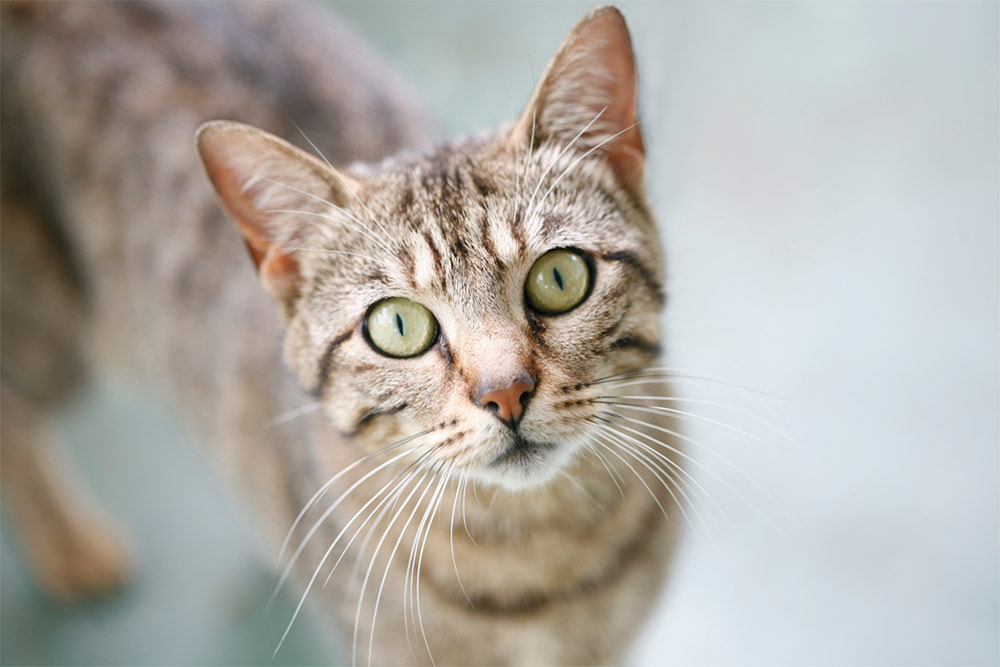The Origins and History of the Tabby Cat
July 13th, 2021

Tabby cats have unique personalities that some cat enthusiasts compare to dogs. It’s not uncommon for these remarkable felines to follow their human family members around just like puppies! Tabby cats love to play and explore and thrive on attention. They are amusing, highly intelligent, and incredibly affectionate, making them excellent household companions!
What Is a Tabby Cat?
Tabby is not an actual, recognized breed but rather, a category of cats with unique markings on their coats. You’ll often see a characteristic “M” on the forehead, right above the eyes. A tabby pattern can be found across a wide range of purebred cats and in mixed breeds. The most familiar tabby coats are black, but some variations in the pigment result in brown, orange, and gray tabbies. Interestingly, orange tabby cats are usually male, with only about 20-25 percent of them being female.
The Origins and History of the Tabby Cat
Tabby cats got their name by being compared to striped cloth and silk from the “Attabiy” district in Baghdad. The 14th century Middle French term was “atabis,” which then became “tabis,” and eventually our English word, “tabby.” A large study using DNA analysis to trace the geographical dispersal and domestication of these beloved felines from ancient to modern times revealed that the tabby cat’s distinctive coat appeared in the Middle Ages and didn’t become common until about the 18th century.
What Are the Tabby Cat Patterns?
There are five distinct tabby patterns:
- Classic Tabby Cat: Sometimes referred to as a blotched tabby, a classic tabby has a bold, swirling pattern that closely resembles a bullseye.
- Mackerel Tabby Cat: Also known as a tiger cat, a mackerel tabby cat has rings around the tail and legs and narrow solid or broken stripes that run down the sides in a vertical pattern.
- Spotted Tabby Cat: A spotted tabby has large or small spots all over the sides that sometimes appear to be broken mackerel stripes.
- Ticked Tabby Cat: Also known as an Abyssinian tabby or agouti tabby, a ticked tabby doesn’t have stripes or spots but instead has tabby markings on the face and hairs striped with alternating light and dark bands, known as agouti hairs on the body.
- Patched Tabby Cat: Often referred to as a tortoiseshell or tortie, a patched tabby usually has dark or grayish brown and red or orange patches with any of the previous tabby patterns.
Your Friendly Neighborhood Veterinary Hospital
If you are considering adopting a tabby cat, your trusted team at All About Cats Veterinary Hospital is here to help. We are proud to offer a wide range of services to ensure our feline patients enjoy healthy, happy lives. You can always count on our team for purr-fectly compassionate care because, after all, we are all about cats!
Recent Posts
-
Summer Safety Tips for Cat Owners
July 11th, 2024
-
The ABCs of Cat Vaccinations – What Every Cat Owner Should Know
June 5th, 2024
-
Preparing for Travel With or Without Your Feline Friend
May 3rd, 2024
-
How to Feed Cats in a Multiple-Cat Household
April 8th, 2024
-
8 Tips to Get Your Cat in a Carrier
March 5th, 2024
-
Help, My Cat’s Breath Smells!
February 5th, 2024
-
A Quick Guide to Coping with Cat Emergencies
January 8th, 2024
-
Traveling for the Holidays? 6 Things to Do Before Leaving Your Cat
December 14th, 2023
-
What Is Catnip and Is It Safe for Your Cat?
November 2nd, 2023
-
5 Tips for New Cat Owners
October 5th, 2023
-
How Often Should My Cat Have a Health Check?
September 7th, 2023
-
Cat Hairballs – What Do I Need to Know?
August 4th, 2023
-
How to Play with Your Cat: Fun Cat Activities
July 4th, 2023
-
What to Know About Your Cat’s Surgery
June 10th, 2023
-
Licensed Veterinary Technician or Technician Assistant Wanted (Full time or Part time)
May 15th, 2023
-
Why, Oh Why, Does My Cat Hate Water?
May 9th, 2023
-
What’s Wrong with My Cat? Benefits of Whole-Body Radiology
April 5th, 2023
-
Should I Feed My Cat a Grain-Free Diet?
March 6th, 2023
-
Smelly Cat, Smelly Cat – Causes of Feline Odors
February 22nd, 2023
-
5 Ways to Reduce Cat Shedding
January 3rd, 2023
-
Your Cat’s Holiday Stress – How to Help
December 6th, 2022
-
Pet Cancer Awareness Month: Warning Signs to Look Out For
November 2nd, 2022
-
10 Halloween Safety Tips for Cat Owners
October 3rd, 2022
-
Why Is My Cat So Active at Night?
September 7th, 2022
-
Should I Really Microchip My Cat?
August 9th, 2022
-
Ways to Keep Your Cat Safe and Cool This Summer
July 1st, 2022
-
10 Fascinating Facts About Persian Cats
June 1st, 2022
-
How to Correctly Transition Cat Foods
May 6th, 2022
-
What Your Cat’s Tail Is Secretly Trying to Tell You
April 5th, 2022
-
6 Common Household Items That Are Poisonous to Cats
March 1st, 2022
-
How Do I Know if My Cat Needs Dental Surgery?
February 16th, 2022
-
How to Safely Introduce Your Cat to Your New Baby
January 11th, 2022
-
Giving a Cat as a Christmas Gift: How to Do It Responsibly
December 6th, 2021
-
5 Thanksgiving Foods That Are Toxic to Cats
November 5th, 2021
-
Is My Kitty Depressed? Signs to Look For in a Sad Cat
October 7th, 2021
-
Training Tips for New Kitten Owners
September 7th, 2021
-
Taking Your Cat to the Vet: How to Make It a Stress-Free Experience
August 6th, 2021
-
The Origins and History of the Tabby Cat
July 13th, 2021
-
We are hiring a Veterinary Technician!
July 12th, 2021
-
Kitty Claw Control: How and When to Cut Your Cat’s Nails
June 7th, 2021














